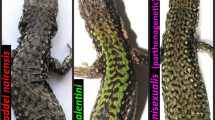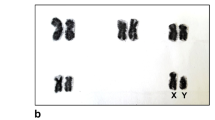Abstract
The karyotypes in spermatogonial and leukocyte metaphases of the toads Bufo bufo, B. viridis and B. calamita (all 2n=22) were analysed and the DNA content of colchicine treated and Feulgen stained spermatogonial metaphase chromosomes measured microspectrophotometrically. The toad species possess similar karyotypes, but the chromosomes of B. bufo are somewhat longer than the chromosomes of B. viridis and B. calamita. All chromosomes of B. bufo contain significantly more than, but in no case twice as much DNA as their homologues in the other two species. Eight chromosomes of B. bufo contain 30–40%, three about 50% more DNA than their homologues in B. viridis. Exactly the same DNA-differences between both sets of chromosomes were found in B. bufo × B. viridis hybrids. Significant differences in the DNA amount of B. viridis and B. calamita exist only between the large chromosomes of these species. The ratio of the total DNA amount of the genomes in the three species is 1.49∶1.07∶1. These DNA-differences between the three toad species are confirmed by microspectrophotometric DNA measurements of their erythrocyte nuclei. It is supposed that these interspecific differences in DNA content of the toads are not a consequence of differential polyteny but are caused during the evolution process by local increase in DNA in all chromosomes of B. bufo and in the large chromosomes of B. viridis.
Zusammenfassung
-
1.
Der Karyotyp der einheimischen Krötenarten Bufo bufo, B. viridis und B. calamita wurde an Colchicin-behandelten Spermatogonien- und Leukocyten-Metaphasen analysiert. Alle Arten besitzen 2n=22 fast vollzählig identifizierbare Chromosomen und weisen strukturell weitgehend übereinstimmende Chromosomensätze auf, so daß die einander entsprechenden Chromosomenpaare der Krötenspecies als homolog betrachtet werden können. Die Chromosomen von B. bufo erscheinen allgemein etwas länger als die der anderen Arten. Heteromorphe Geschlechtschromosomen fehlen.
-
2.
Die Analyse des Chromosomenbestandes von bufo × viridis-Bastarden bestätigt die weitgehende Übereinstimmung der Karyotypen von Erd- und Wechselkröte.
-
3.
An Feulgen-gefärbten Präparaten Colchicin-behandelter Spermatogonien-Metaphasen wurde der DNS-Gehalt der Genome von B. bufo, B. viridis und B. calamita durch cytophotometrische Messungen der einzelnen Chromosomen bestimmt. Für den gesamten DNS-Gehalt der Genome von Erd-, Wechsel- und Kreuzkröte ergibt sich aus diesen Messungen ein Verhältnis von 1,49∶1,07∶1. Nahezu das gleiche Verhältnis (1,48∶1,07∶1) lieferten die an Erythrocytenkernen der drei Krötenarten ausgeführten cytophotometrischen DNS-Bestimmungen.
-
4.
Sämtliche Chromosomen von B. bufo enthalten signifikant mehr DNS als ihre Homologen bei B. viridis und B. calamita, weisen aber in keinem Falle einen auch nur annähernd doppelt so hohen DNS-Gehalt auf. Die meisten Chromosomen von B. bufo besitzen 30–40%, einige ungefähr 50% bzw. 57% mehr DNS als die ihnen homologen Chromosomen von B. viridis. Differenzen im DNS-Gehalt homologer Chromosomen von B. viridis und B. calamita sind nur bei den großen Chromosomen nachweisbar.
-
5.
Die an homologen bufo- und viridis-Chromosomen aus Metaphasen des Augengewebes junger bufo × viridis-Bastardlarven vorgenommenen cytophotometrischen DNS-Bestimmungen bestätigen die Zuverlässigkeit der an den Spermatogonien-Chromosomen gewonnenen Meßresultate.
-
6.
Die Untersuchungsergebnisse widerlegen hertwig s (1930, 1956) Hypothese, die Chromosomen von B. bufo seien im Vergleich zu denen der beiden anderen Krötenarten doppelsträngig (dinem); denn nach jener Annahme müßte ein 2∶1-Verhältnis im DNS-Gehalt der homologen Chromosomen bzw. der Genome von B. bufo und B. viridis oder B. bufo und B. calamita bestehen. Auf Grund der vorliegenden Befunde werden die interspezifischen Unterschiede im DNS-Gehalt der Bufo-Arten nicht auf eine differentielle Polytänie der Chromosomen, sondern auf lokale DNS-Zunahme in den Chromosomen (Duplikationen) während der Artdifferenzierung zurückgeführt.
Similar content being viewed by others
Literatur
Alfert, M., and N. O. Goldstein: Cytochemical properties in Tetrahymena pyriformis. J. exp. Zool. 130, 403–422 (1955).
—, and W. Balamuth: Differential micronuclear polyteny in a population of the ciliate Tetrahymena pyriformis. Chromosoma (Berl.) 8, 371–379 (1957).
Arakaki, D. T., and R. S. Sparkes: Microtechnique for culturing leukocytes from whole blood. Cytogenetics 2, 57–60 (1963).
Bachmann, K., and R. R. Cowden: Quantitative cytophotometric studies on isolated liver cell nuclei of the bullfrog, Rana catesbeiana. Chromosoma (Berl.) 17, 22–34 (1965a); - Quantitative cytophotometric studies on polyploid liver cell nuclei of frog and rat. Chromosoma (Berl.) 17, 181–193 (1965b).
Bianchi, N. O., and R. Laguens: Somatic chromosomes of Bufo arenarum. Cytologia (Tokyo) 29, 151–154 (1964).
Galgano, M.: Evolutione deglei spermatociti di I ordine e cromosomi pseudosessuali in alcune di anfibi. Arch. ital. Anat. Embriol. 32, 171–200 (1933).
Gall, J. G.: Kinetics of deoxyribonuclease action on chromosomes. Nature (Lond.) 198, 36–38 (1963a);- Chromosomes and cytodifferentiation. In: Cytodifferential and macromolecular synthesis. New York: Academic Press 1963.
Halkka, O.: A photometric study of the Luzula problem. Hereditas (Lund) 52, 81–88 (1964).
Hertwig, G.: Kern- und Zellgrößenunterschiede der Eltern als Ursache des verschiedenen Ausfalls reziproker Krötenbastarde. Z. Anat. 92, 718–739 (1930); - Hochgradige Polynemie der Chromosomen als Ursache der vergleichsweise erheblichen Zell- und Kerngrößen der Amphibien. Verh. anat. Ges. (Jena) 53, 104–112 (1956).
—, G. Ruhland u. I. Weiss: Die Kerngrößen triploider Krötenbastarde mit experimentell verdoppeltem mütterlichen Genom. Z. mikr. anat. Forsch. 64, 129–158 (1958).
—, u. I. Weiss: Die Auswirkung der Vereinigung von Genomen, die ungleichen Kernklassen angehören, auf die Entwicklungsfähigkeit reziproker Krötenbastarde. Morph. Jb. 95, 1–34 (1955).
— u. Ch. Ziemann: Unterschiedliche Ergebnisse reziproker Kreuzungen der drei europäischen Krötenarten unter besonderer Berücksichtigung ihrer Kern- und Zellgrößen. Biol. Zbl. 78, 675–702 (1959).
Hughes-Schrader, S.: The meiotic chromosomes of the male Llaveiella taenechina Morrison (Coccoidea) and the question of the tertiary split. Biol. Bull. 78, 312–337 (1940); - Differential polyteny and polyploidy in diaspine coccids (Homoptera: Coccoidea). Chromosoma (Berl.) 8, 709–718 (1957); - The DNA content of the nucleus as a tool in the cytoaxonomic study of insects. Proc. 10th Intern. Congr. Entomol. 2, 935–944 (1958).
—, and P. Schrader: Polyteny as a factor in the chromosomal evolution of the Pentatomini (Hemiptera). Chromosoma (Berl.) 8, 135–151 (1956); - The Nezara complex (Pentatomidae-Heteroptera) and its taxonomic and cytological status J. Morph. 101, 1–24 (1957).
Kaufmann, B. P., H. Gay, and M. R. McDonald: Organizational patterns within chromosomes. Int. Rev. Cytol. 9, 77–127 (1960).
Keyl, H.-G.: Verdopplung des DNS-Gehalts kleiner Chromosomenabschnitte als Faktor der Evolution. Naturwissenschaften 51, 46–47 (1964); - A demonstrable local and geometric increase in the chromosomal DNA of Chironomus. Experientia (Basel) 21, 191–193 (1965a); - Duplikationen von Untereinheiten der chromosomalen DNS während der Evolution von Chironomus thummi. Chromosoma (Berl.) 17, 139–180 (1965b).
Kretschmann, H.: Variationsstatistische Kernmessungen an den männlichen Geschlechtszellen von Bufo viridis und Bufo vulgaris. Morph. Jb. 96, 90–105 (1955).
LaCour, L. F., and S. R. Pelc: Effect of colchicine on the utilization of labelled thymidine during chromosomal reproduction. Nature (Lond.) 182, 506–508 (1958).
Matthey, R.: Les chromosomes des vertébrés. Lausanne: Rouge 1949.
Mello-Sampayo, T.: Differential polyteny and karyotype evolution in “Luzula”, a critical interpretation of morphological and cytophotometric data. Genet. iberica 13, 1–22 (1961).
Mirsky, A. E., and H. Ris: The deoxyribonucleic acid content of animal cells and its evolutionary significance. J. gen. Physiol. 34, 451–462 (1951).
Peacock, W. J.: Chromosome duplication and structure as determined by autoradiography. Proc. nat. Acad. Sci. (Wash.) 49, 793–801 (1963).
Poska-Teiss, L.: Spermatogonien von Bufo vulgaris Laur. und ihr Vergleich mit larvalen somatischen Zellen desselben Tieres. Z. Zellforsch. 17, 347–419 (1933).
Prescott, D. M., and M. A. Bender: Autoradiographic study of chromatid distribution of labelled DNA in two types of mammalian cells in vitro. Exp. Cell Res. 29, 430–442 (1963).
Ris, H.: Ultrastructure and molecular organization of genetic systems. Canad. J. genet. Cytol. 3, 95–120 (1961).
Saez, F. A., P. Rojas u. E. De Robertis: Untersuchungen über die Geschlechtszellen der Amphibien (Anuren). Der meiotische Prozeß bei Bufo arenarum. Z. Zellforsch. 24, 725–777 (1936).
Schrader, F., and S. Hughes-Schrader: Polyploidy and fragmentation in the chromosomal evolution of various species of Thyanta (Hemiptera). Chromosoma (Berl.) 7, 469–496 (1956).
Shah, V. C.: An improved technique of preparing primary cultures of isolated cells from adult frog kidney. Experientia (Basel) 18, 239–240 (1962).
Sparvoli, E., H. Gay, and B. P. Kaufmann: Number and pattern of association of chromonemata in the chromosomes of Tradescantia. Chromosoma (Berl.) 16, 415–435 (1965).
Stohler, R.: Cytologische Untersuchungen an den Keimdrüsen mitteleuropäischer Kröten. Z. Zellforsch. 7, 400–475 (1928).
Taylor, J. H.: Sister chromatid exchange in tritium labelled chromosomes. Genetics 43, 515–529 (1958);- Chromosome reproduction. Int. Rev. Cytol. 13, 39–73 (1962); - The replication and organization of DNA in chromosomes. In: Molecular genetics, p. 65–111, ed. by J. H. Taylor. New York: Academic Press 1963.
—, P. S. Woods, and W. L. Hughes: The organization and duplucation of chromosomes as revealed by autoradiographic studies using tritium labelled thymidine. Proc. nat. Acad. Sci. (Wash.) 43, 122–128 (1957).
Ullerich, F.-H.: Unterschiede im DNS-Gehalt der Genome von Bufo bufo und Bufo rividis. Z. Naturforsch. 20b, 720–722 (1965).
Weiler, C., and S. Ohno: Cytological confirmation of female heterogamety in the African water frog (Xenopus laevis). Cytogenetics 1, 217–223 (1962).
Weiss, I.: Die Kern- und Zellgrößen der Erd- und Wechselkröte und ihres erwachsenen Bastards. Verh. anat. Ges. (Jena) 53, 99–103 (1956).
White, M. J. D.: Animal cytology and evolution, 2nd ed. Cambridge: Cambridge Press 1954.
Wickbom, T.: Cytological studies on Dipnoi, Urodela, Anura, and Emys. Hereditas (Lund) 31, 241–346 (1945); - Further cytological studies on Anura and Urodela. Hereditas (Lund) 35, 33–48 (1949a); - A new list of chromosome numbers in Anura. Hereditas (Lund) 35, 242–245 (1949b).
Woods, P. S., and M. U. Schairer: Distribution of newly synthesized deoxyribonucleic acid in dividing chromosomes. Nature (Lond.) 183, 303–305 (1959).
Yosida, T. H.: Sex chromosomes of the tree frog, Hyla arborea japonica. J. Fac. Sci. (Ser. 6), Hokkaido Univ. 13, 352–358 (1957).
Ziemann, Ch.: Inwieweit lassen sich die ontogenetisch und phylogenetisch bedingten Kern- und Zellgrößenunterschiede bei Amphibien einheitlich deuten ? Wiss. Z. Univ. Halle, math.-nat. Reihe 8, 799–822 (1959).
Author information
Authors and Affiliations
Additional information
Herrn Professor Dr. J. Seiler zum 80. Geburtstag gewidmet.
Rights and permissions
About this article
Cite this article
Ullerich, F.H. Karyotyp und DNS-Gehalt von Bufo bufo, B. viridis, B. bufo × B. viridis und B. calamita (Amphibia, Anura). Chromosoma 18, 316–342 (1966). https://doi.org/10.1007/BF00326875
Received:
Issue Date:
DOI: https://doi.org/10.1007/BF00326875




